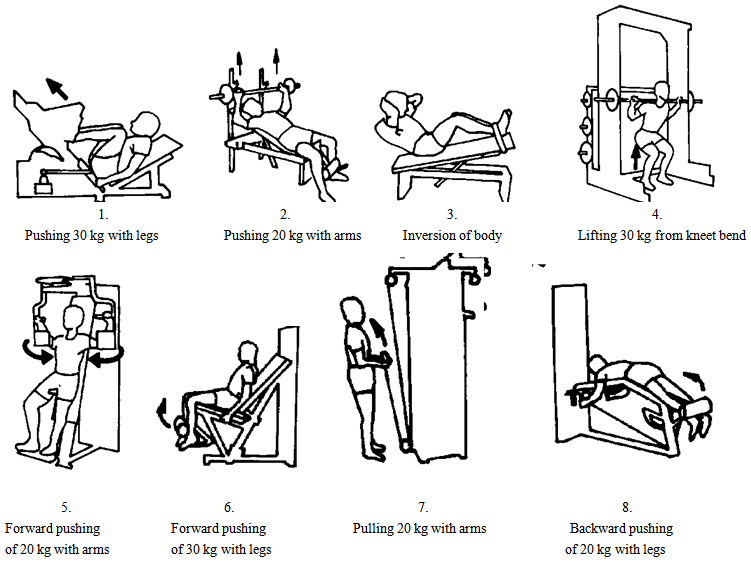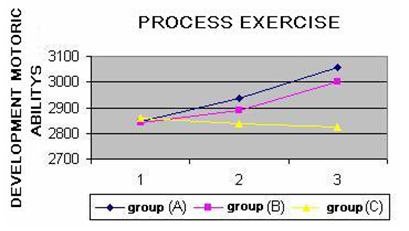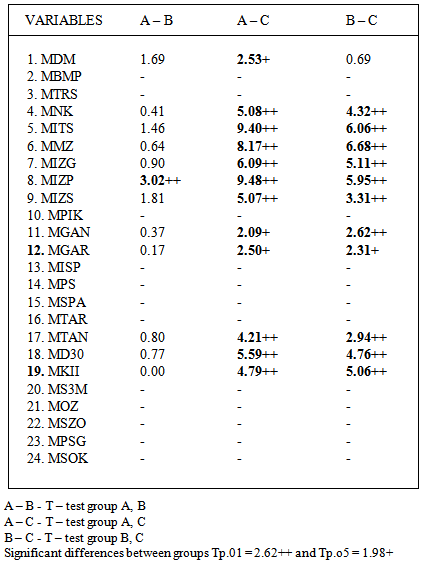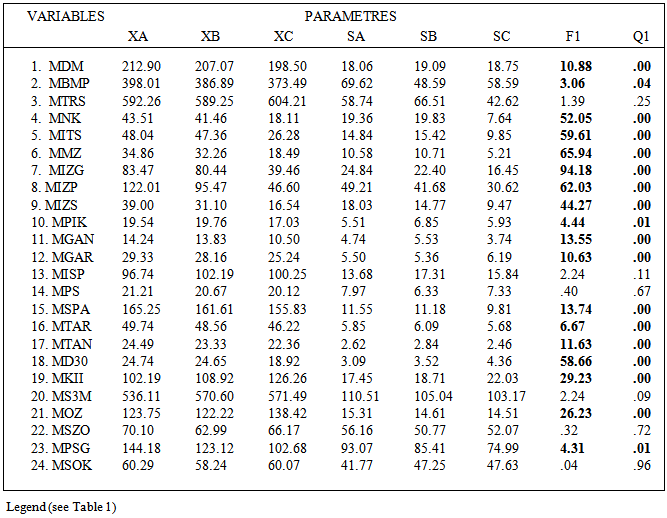-
Paper Information
- Next Paper
- Paper Submission
-
Journal Information
- About This Journal
- Editorial Board
- Current Issue
- Archive
- Author Guidelines
- Contact Us
International Journal of Sports Science
p-ISSN: 2169-8759 e-ISSN: 2169-8791
2014; 4(4): 121-129
doi:10.5923/j.sports.20140404.01
Changes Manifest Motor Abilities under the Influence Applications of Isometric and Isotonics of Operators
Miroslav Dodig
University of Rijeka, 51216 Viškovo, Kosi 66, Croatia
Correspondence to: Miroslav Dodig, University of Rijeka, 51216 Viškovo, Kosi 66, Croatia.
| Email: |  |
Copyright © 2014 Scientific & Academic Publishing. All Rights Reserved.
The basic aim of this research is to changes and difference in changes of manifested motor abilities under influence of application of isometric and isotonic operators. On the samples of 216 male examinees 15 years of age, which were sorted into groups A, B and C kinesiologic contents operators were applied. In group A, applied were isometric operators, in group B isotonic operators and in group C which were control group, applied were poly-structural operators of complex motion. In course of three months research, examinee shad weekly three trainings and other days remained for rest. Duration of one training were 60 min. Operating context in experimental group were identical in biomechanics base structure. Form of work which were used were cells system and circle working method. Volume end distribution of applied operators were individually programmed based on initial state, taking 70% of maximal duration valuation or repeating number in each operator. Progressive discontinued duration or operators performance numbers were programmed from initial state through transitive until final state. Examinees motor abilities were determined by use of measuring instruments. Measuring were effected at the beginning, middle and end of examination and were than analysed. Groups of first, second and third measure were analysed through variance analyse and according to importance of group differences, tests were made of differences of arithmetic centres. Motor abilities initial state had very important changes, depending on type of applied operators. Applied isometric operators, in comparison to applied isotonic operators under identical conditions were more important in development of motor abilities, static strength, speed, flexibility and coordination.
Keywords: Motor abilities, Transformation process, Isometric operators, Isotonic operators, Basic statistics, Alterations
Cite this paper: Miroslav Dodig, Changes Manifest Motor Abilities under the Influence Applications of Isometric and Isotonics of Operators, International Journal of Sports Science, Vol. 4 No. 4, 2014, pp. 121-129. doi: 10.5923/j.sports.20140404.01.
Article Outline
1. Introduction
- Human body is moved by contractions of muscle fibres that transfer force via tendon ends on bone levers. The activation of muscles causes the release of mechanical energy used to produce force. The components of mechanical energy are force and displacement. Force is necessary to keep the existing position or to resist a stronger force, i.e. gravitation. Isotonic contraction occurs when muscle force is greater than the exterior force. When they are equal isometric contraction occurs, and when the muscle force is smaller than the exterior force plyometric contraction occurs. Studies results (Bass, R.I., (1939), Hettinger, T., (1972, 1975), Dodig, M., 1979, 1983, 1998, 2002, 2007), Jansen, R.K., (1976) show the advantages of isometric exercises in respect to isotonic. On the other side Berger, R.A., (1962, 1964), Rasch, J.P., & Burke, R.K., (1968) imply that isotonic exercises are in advantage. But researches that were done by Asmussen, E., Hansen, O., Lammert, O., (1954), Dennison, J.D., Howell, M.L., & Morford, W.R., (1961) show that there are no considerable differences in the increase of strength when applying isometric and isotonic trainings.It is important to emphasize the exploration of the relationship among Isometric, Isotonic, and Isokinetic Concentric and Eccentric Components. Anderson, M.A., Gieck, J.H., Perrin, D.H., Weltman, A., Rutt, R., & Denegar, C. (1991). In addition, effects of maximal isometric and isokinetic resistance training on strength and functional mobility in older adults, confirmed the significant impact of process. Symons, T.B., Vandervoort, A.A., Rice, C.L., Overend, T.J. & Marsh. G.D, (2005). There are different research results probably due to different means, methods, intensities and duration of training. Researches so far have not examined the influence of isometric and isotonic trainings on motor abilities in whole, and especially not when isometric and isotonic operators varied in duration. Researches of isometric (Brunner, J.A., (1967), Hermansen, L., (1981), and isotonic trainings (Hellebrandt, F.A., Houtz, S.J., (1956) with varied duration and intensity of exercises so far were mostly achieved in laboratory conditions. The aim of this research is to establish the level of influence and the difference in influence of isometric and isotonic operators on development of manifest motor abilities, while the main aim is to comprehend the changes of manifest motor abilities under the influence of application of isometric and isotonic operators, as well as their importance. Isometric and isotonic operators with equal kinetic structure were applied. The type of stimulus of corresponding intensity and duration was varied. In this sense an experimental drawing was done which defined optimal conditions necessary to vary only the type of muscle work.
2. Methods
2.1. Participants
- The population from which the sample for this research was defined consisted of 216 male examiners, of 15 years of age. The choice of sample was random since the operations of forming and sorting into groups A, B and C were done independently of this type of research. Groups were taken as already administratively formed classes of secondary schools, and therefore the sample can be considered random. On the day when measurement was done, due to the nature of group and research, examinees had to fulfill, except general conditions, the condition not to interrupt the continuity of exercise more than three times and not to do other types of exercise during this experiment. The effective of the sample was planned in order to enable that many degrees of freedom so that P.01 = 1.98 and P.05 = 1.98 differences could be statistically relevant 72 examinees were necessary in each group. In such a way the total effective of the sample was 216 examinees. 240 examinees were included, 80 in each group. Some were eliminated for not having fulfilled the research conditions. In accordance with intentional measuring subject, a battery of 24 motor tests was constructed, which brought information in many tests so far. Performed validation tests they gave satisfactory reliability test Dodig, M., (2007). Full name, cipher and ordinal number used in text and tables are mentioned in each test. For each motor ability three tests were applied:(1) EXPLOSIVE STRENGTH; 1.long jump without running (MDM), 2. throwing medicine ball while lying down (MBMP), 3. hop, skip and jump without running (MTRS)(2) REPETITIVE STRENGTH; 1. jump upon a small bench with one third of weight (MNK), 2. trunk erection – on Swedish crate (MITS), 3. mixed crossbar body lifting (MMZ)(3) STATIC STRENGTH; 1.maintenance in crossbar body lifting (MIZG), 2. maintenance in half knee-bend with one half of body weight (MIZP), 3. maintenance on parallel bars (MIZS) (4) PRECISION; 1. darts (MPIK), 2. aiming at vertical target with leg (MGAN), 3. aiming at horizontal target with arm (MGAR) (5) FLEXIBILITY; 1. inversion with stick (MISP), 2. sitting inversion (MPS), 3. side string (MSPA)(6) SPEED; 1. hand tapping (MTAR), 2. leg tapping on the wall (MTAN), 3. trunk lifting in 30 seconds (MD30)(7) COORDINATION; dexterity with stick (MKOP), 2. slalom with three balls (MS3M), 3. dexterity in air (MOZ)(8) BALANCE; 1. standing on one foot with closed eyes (MSZO), 2.cross standing on a low bench (MPSG), 3. standing on turned bench for balance (MSOK)
2.2. Procedure
- The research was done in two phases; preparation and realization phase.Preparation phase – research planning was done as well as the battery of measuring instruments chosen. The place and time of research was fixed. The operator content in experimental groups was defined; it was based on kinetic structures that fulfill the requirements of this research, and are directed towards changing the motor abilities. The operator content consisted of kinetic structures that are realized due to resistance of own body and in form of weightlifting exercises. The choice of operator content was defined topologically according to particular muscle regions – arms and shoulder region, trunk and legs (Picture 1.)
 | Picture 1. Survey of kinetic structures that were applied as isometric and isotonic operators in experimental procedure |
2.3. Data Processing Methods
- Transformation, condensation and statistic data processing methods were chosen in accordance with the demands of data analysis. The central and dispersion parameters of particular variables were calculated; for the first, second and third measurement for each group. The differences between groups in each particular variable for estimation of motor abilities in initial, transitive and final state were tested in accordance with the univariant analysis of variance. The F-test and probability Q was calculated, so there was no group difference. Considerable group differences in some variables were tested with the T-test for two independent groups with significance level P.01 = 2.62, which was marked ++, and significance level P.05 = 1.98, marked with +.
3. Results
- The results are presented as requested by easy reference and logic to prove the set hypothesis. The presentation of results and discussion was divided into the initial, transitive and final examinee’s state, as well as into transformation states depending on operator application.Analysis of the initial state - the differences between groups in applied variables were analysed with variance analysis. In Table 1, the following values are stated: arithmetic mean of each group (XA, XB, XC) for each variable; standard deviation (SA, SB, SC); F- test and probability Q that between arithmetic means (calculated with 2 and 213 degrees of freedom) there are no differences.During the first measurement or initial state of examinee, the differences of arithmetic means in particular variables are not great, which might have been expected because examinees belong to the same population. The probability that arithmetic means of groups are equal in particular measuring instruments is very high. This does not apply only to three variables, these being: MITS, MGAR and MD30, where differences are statistically confirmed. Variability measured with standard deviation is satisfactory, with this that it is slightly appointed at some variables, probably due to some low or high results, which affect the extent of result range. Analysing disperse parameters, a higher homogeneity of variable results can be noticed in group C, less in group A, and the least in group B. The significance of differences of arithmetic means for each particular variable was tested by the F– test. By inspection of Table 1 it can be noted that values F and Q permit a conclusion that between arithmetic means of particular examinee’s groups there is no considerable statistical difference on the level from P=. 01 and P =. 05 in all treated variables. This data indicates that the hypothesis to be accepted is the following: in the first measurement between groups there is no considerable statistical difference, which means that groups in their initial state behave in a similar way in respect to their motor abilities. This similarity and alignment of groups enables group differences to be more clearly visible in the process of operator application.
|
|
|
|
|
4. Discussion
- On the sample of 216 male examinees of 15 years of age, sorted into groups A, B and C kinesiologic operators with corresponding content were applied. Isometric operators were applied in group A, isotonic in group B, and poly-structural operators of complex motion (basketball and football) in group C, which was the control group.In the course of three months research, examinees had three trainings weekly, with resting days in between. Each training lasted for 60 minutes. The contents and methods in all of experimental groups were identical in the basic biomechanical structure of operators. The cell system and circle working method were the forms of work used. Volume and distribution of operator application were individually foreseen on basis of the initial state. This was done so that 70% of maximal values of endurance or number of repetitions in single operator were taken. Progressive discontinued duration or number of operator performances was programmed. Volume and operator distribution was progressively and discontinuously programmed from the initial state of 70%, through the transitional state of 90 % and towards the final state of 120% in each operator. 24 motor tests were applied for the estimation of motor abilities of examinees. Measuring was done at the beginning, in the middle and at the end of examination, and then analysed. Group differences between the first, second and third measurement were analysed through variance analysis; and according to the significance of group differences, the differences between arithmetic means were tested (Picture 2.).
 | Picture 2. Presentation development motoric ability |
 Abstract
Abstract Reference
Reference Full-Text PDF
Full-Text PDF Full-text HTML
Full-text HTML



